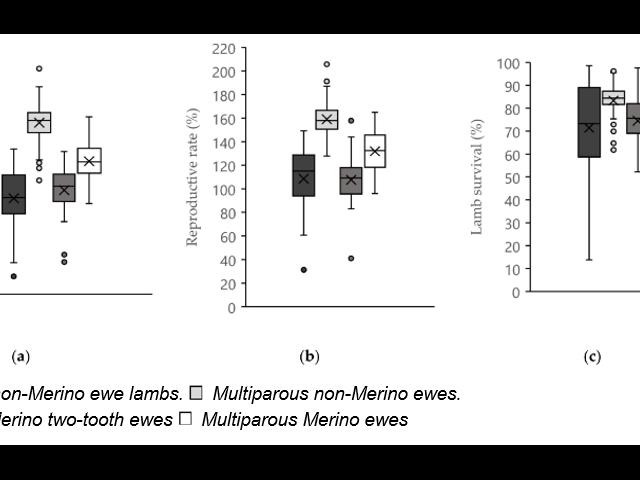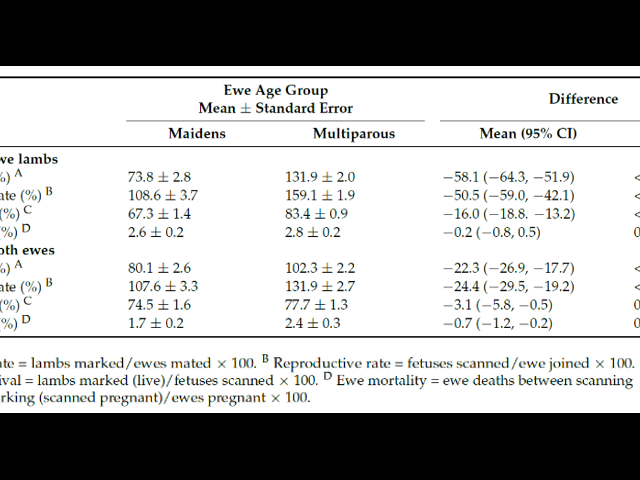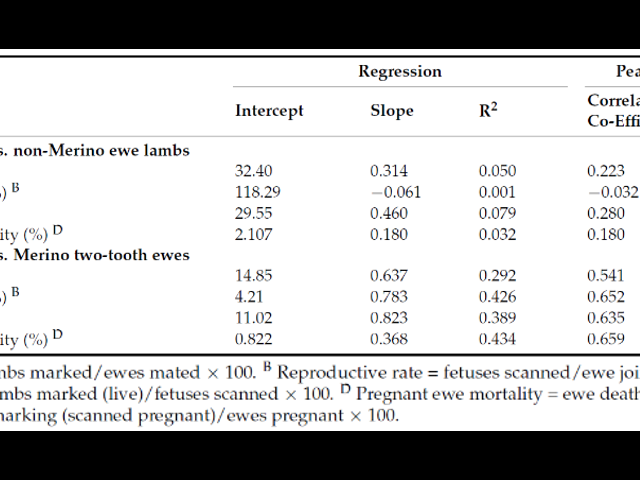The reproductive performance of maiden ewes across Australia
Dayna Hutchison, DPIRD Merredin, WA; Bronwyn Clarke, Serina Hancock, Andrew Thompson, Elise Bowen and Caroline Jacobson, Murdoch University Perth, WA
Author correspondence: dayna.hutchison@dpird.wa.gov.au, c.jacobson@murdoch.edu.au
Introduction
It is widely accepted that the reproductive performance of ewes in their first breeding season (maiden ewes) can be poorer and more variable than at subsequent breeding seasons. However, the extent and causes of the poorer reproductive performance of maiden ewes on Australian sheep farms are not well understood. Improving the reproductive performance of maiden (primiparous) ewes lambing for the first time at either 12 months of age (ewe lambs) or at 24 months of age (two-tooth or hogget) would have a significant effect on the efficiency of the Australian sheep flock. This is a key priority for the Australian sheep industry as we endeavour to rebuild the national flock, increase production to meet increasing consumer demands, mitigate greenhouse gas emissions and improve animal welfare. However, in order to improve the reproductive performance of maiden ewes, we must first understand where the inefficiencies are occurring.
Aims
This study aimed to determine the difference in reproductive performance between maiden and multiparous ewes across major sheep producing regions of Australia to inform strategies to improve reproductive performance in maiden ewes. We hypothesised that (i) maiden ewes joined either as ewe lambs or two-tooth ewes will have lower marking rates than multiparous ewes, and (ii) this will be due to a combination of lower reproductive rate and lower lamb survival between scanning and marking.
Methods
This study surveyed sheep producers from Western Australia, South Australia, Victoria, New South Wales and Tasmania. Sheep producers were recruited for the survey between 2019 and 2021 and completed a questionnaire focused on reproductive performance for ewes that lambed between 2018 and 2020. This included data recorded at pregnancy scanning (typically conducted 70–90 days from the start of mating period) and lamb marking (tail docking).
Respondents were selected for inclusion in the survey on the basis that:
- They separately managed maiden ewes mated as ewe lambs (7–10 months at start of mating period) or two-tooth ewes (16–22 months at start of mating period);
- Utilised pregnancy scanning by transabdominal ultrasonography to determine the number of foetuses for maiden and multiparous ewes; and
- Were able to determine lamb survival to marking for maiden and multiparous ewes on the same property, which generally required managing maiden ewes separately from multiparous ewes during lambing.
Very few responses were received for Merino ewe lambs and non-Merino maiden two-tooth ewes during the first 12 months of the study, so they were subsequently excluded from the survey, and only non-Merino ewe lambs and Merino two-tooth ewes were targeted thereafter.
The questionnaire collected details regarding the general farm characterisation, followed by 3 sections pertaining to reproductive performance: data for maiden ewes at scanning, for maiden ewes at lamb marking and for multiparous ewes at scanning and lamb marking. Sheep data were collected for each mob of maiden ewes and for the total population of multiparous ewes for each farm. Critical data included mob size at joining, age, dam and sire breed, month of joining, body condition score at joining, mob size at scanning, number of foetuses identified at scanning, and number of dry ewes. Producers were given the opportunity to volunteer additional information such as length of joining period, condition score at joining and lambing, predominant pasture types, feed-on offer and supplementary feeding strategies.
All statistical analyses were performed using GENSTAT (VSN International 2017, Hemel Hempstead, UK) and IBM SPSS Statistics (version 24) (IBM 2021, Armonk, NY, USA). For all analyses, main effects and interactions were only included if they were statistically significant (p < 0.05).
Results and discussion
To our knowledge, this is the first study to compare the marking rate of maiden and multiparous ewes and their components on commercial farms across Australia. A total of 79 respondents provided complete data for maiden and multiparous ewes and were eligible for inclusion in the study. Of these, 16 producers contributed data for two years, and three producers contributed data for three years to give a total of 103 survey responses that represented 111 117 maiden ewes managed in 307 mobs from lambing to marking. A total of 302 585 multiparous ewes were included in eligible survey responses.
The mean farm size was 3750 hectares (range: 230–115 000 hectares), and the mean number of breeding ewes per farm was 4762 (range: 477–25 000 ewes). The average age at joining of maiden ewes analysed in the Merino two-tooth category was 18.5 months. The average age at joining of maiden ewes analysed in the non-Merino two tooth category was 8 months.
The inclusion criteria generated bias in the sample population because only producers that utilised pregnancy scanning for litter size were eligible for inclusion. Subsequently, the sampled population likely included a higher proportion of ewes that were differentially managed according to litter size compared to the general population. It is possible that producers that have adopted pregnancy scanning were more likely to adopt other management strategies that could impact reproductive performance compared to the broader population. As such, the findings of this study should only be generalised to Australian sheep producers that have adopted pregnancy scanning and should not be extrapolated across the national sheep flock.
Reproductive Performance in Maiden and Multiparous Ewes
Marking rate, reproductive rate and lamb survival for maiden and multiparous ewes are shown in Figure 1. A key difference between maiden ewe lambs and maiden Merino two-tooth ewes and both multiparous ewes was the wider variation in lamb survival and, to a lesser extent, reproductive rate and marking rate between flocks (Figure 1).

Maiden ewes had a lower marking rate, reproductive rate and lamb survival compared to multiparous ewes on the same farm. The average difference in marking rate between maiden and multiparous ewes was 58% for non-Merino ewe lambs and 22% for maiden Merino two-tooth ewes. Lower marking rate in ewe lambs was attributable to differences of 51% for reproductive rate and 16% for lamb survival. The poorer marking rates of maiden Merino two-tooth ewes compared with their multiparous counterparts was largely attributable to a 24.4% difference in reproductive rate, whilst the difference for lamb survival was only 3% (Table 1).

Development and adoption of management strategies to improve marking rate for non-Merino ewe lambs should focus on improving both reproductive rate and lamb survival as they contributed nearly equally to the differences in marking rate compared to multiparous ewes. By contrast, the poorer marking rate of Merino two-tooth ewes compared with their multiparous counterparts were largely due to differences in reproductive rate. Nevertheless, the development and adoption of strategies to improve marking rates for Merino two-tooth ewes should also focus on improving both reproductive rate and lamb survival. In this study, lamb survival was relatively low for both two-tooth and multiparous Merino ewes, suggesting that improved lamb survival for Merino ewes across all age groups remains an issue for the Australian sheep industry.
There were moderate positive correlations between maiden Merino two-tooth ewes and their multiparous counterparts for marking rate, reproductive rate, lamb survival and ewe survival (Table 2). In contrast, there was a very weak positive correlation between ewe lambs and their multiparous counterparts for lamb survival and no correlation for reproductive rate, marking rate or ewe survival (Table 2).

Development and adoption of management strategies to improve marking rate for non-Merino ewe lambs should focus on improving both reproductive rate and lamb survival as they contributed nearly equally to the differences in marking rate compared to multiparous ewes. By contrast, the poorer marking rate of Merino two-tooth ewes compared with their multiparous counterparts were largely due to differences in reproductive rate. Nevertheless, the development and adoption of strategies to improve marking rates for Merino two-tooth ewes should also focus on improving both reproductive rate and lamb survival. In this study, lamb survival was relatively low for both two-tooth and multiparous Merino ewes, suggesting that improved lamb survival for Merino ewes across all age groups remains an issue for the Australian sheep industry.
The weak and generally non-significant correlation between the reproductive performance of ewe lambs and their multiparous counterparts in the current study hinged on the more variable performance of ewe lambs. Past research suggests that variance is likely attributed to the greater effect of live weight at the start of the mating period and live weight gain during the mating period, condition score at mating and age of the breeding ewe (Adalsteinsson et al. 1979, Clune et al. 2022, Thompson et al. 2021, Thompson et al. 2019, Viñoles et al. 2012). This suggests that whilst strategies to increase reproductive performance in Merinos may be generalised to both maiden and multiparous ewes, there may be an opportunity to tailor development of management strategies for non-Merino ewe lambs in comparison to strategies used for non-Merino multiparous ewes.
Conclusion
Maiden ewe reproductive performance is a key area for improvement in the Australian sheep flock. This survey suggests that for non-Merino maiden ewes, reduced reproductive performance is equally attributable to lower reproductive rate and lower lamb survival and therefore both remain of high priority for future research. The reduced reproductive performance of maiden Merino ewes was largely attributable to reproductive rate which suggests future research should be directed towards increasing the fecundity of Merino maiden ewes and the survivability of the embryos to late pregnancy. Strategies specific to ewe lambs may be required because their reproductive performance was not correlated with multiparous ewes on the same farm.
A copy of the full article can be found in Hutchison et al (2022).
References
Adalsteinsson, S (1979). The independent effects of live weight and body condition on fecundity and productivity of Icelandic ewes. Animal Sci, 28, 13–23. https://doi.org/10.1017/S0003356100023011
Clune T, Lockwood A, Hancock S, Thompson AN, Beetson S, Campbell AJD, Glanville E, Brookes D, Trengove C, O’Handley R, et al (2022). Abortion and lamb mortality between pregnancy scanning and lamb marking for maiden ewes in southern Australia. Animals, 12, 10. https://doi.org/10.3390/ani12010010
Thompson, AN, Bowen E, Keiller J, Pegler D, Kearney G, Rosales-Nieto CA (2021). The number of offspring weaned from ewe lambs is affected differently by liveweight and age at breeding. Animals, 11, 2733. https://doi.org/10.3390/ani11092733
Thompson A, Bairstow C, Ferguson M, Kearney G, Macleay C, Thompson H, Paganoni B (2019). Growth pattern to the end of the mating period influences the reproductive performance of merino ewe lambs mated at 7 to 8 months of age. Small Rumin. Res., 179, 1–6. https://doi.org/10.1016/j.smallrumres.2019.08.007
Viñoles C, Glover KMM, Paganoni BL, Milton JTB, Martin GB (2012). Embryo losses in sheep during short-term nutritional supplementation. Reprod. Fertil. Dev, 24, 1040. https://doi.org/10.1071/RD11281

